I’m really excited about this! And I think many of you will be, too, especially if you’re a Linen-Lover!
I wanted to work up a nice little sample project to show off this new linen for you, but instead, I worked up a rustic little (read: pathetic and tiny) few stitches to help illustrate what I really like about this linen. I have a small project planned for this particular linen, and it will show up some time before Christmas.
In the meantime, without further ado, let’s move on to the introductions!
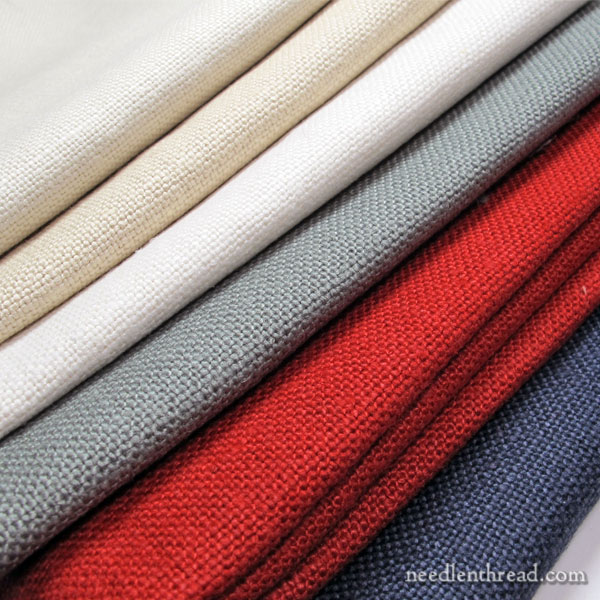
My friends, please meet Provincial, the new 20-count needlework linen in the Legacy Linen line from Access Commodities.
By 20-count linen, I mean that there are 20 threads per inch in this linen
When a linen is called a “something-count” linen, it’s assumed that it’s an even-weave linen, which can be used for counted needlework techniques like cross stitch, blackwork, Hardanger, and the like.
But there’s a lot more to this linen!
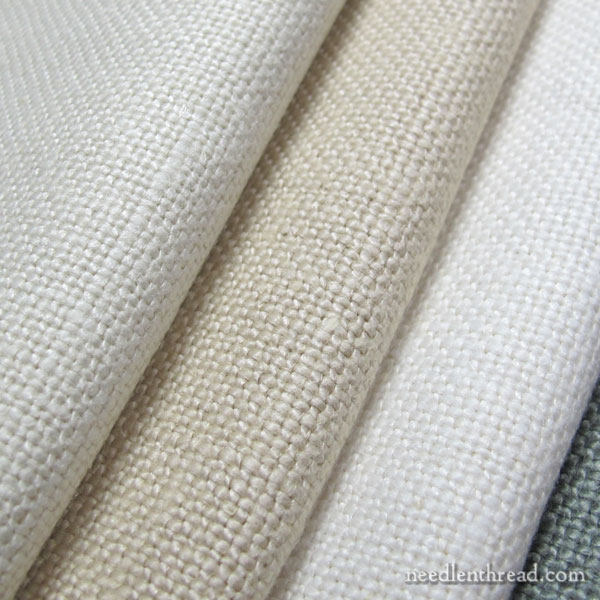
Provincial comes in six colors. The more neutral colors include (from left to right) Taffeta Cream, Buttermilk Biscuit, and Ivory Piano Key.
It’s really difficult to get the colors of the fabrics across online. The Buttermilk Biscuit is kind of a light golden color, like a wheat field ready for harvest, blowing in the wind. It’s a beautiful color! And perfect for antique reproduction samplers and the like.
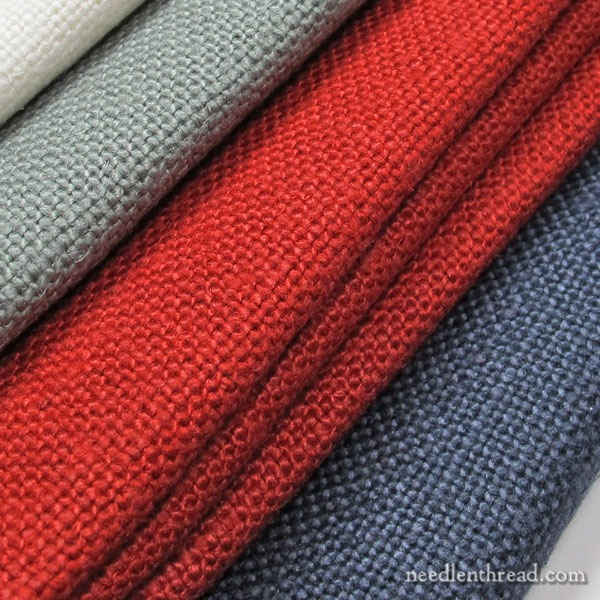
The other three colors in the line up are, from left to right, Silver Pine Needle, which is a subtle grey-silver with just a hint of green to it; Crimson Crinoline, which is a deep, bright true red, not orangey at all, but a thoroughly noble red (very hard to find in good needlework linen!); and Sea Water Black, which is a kind of washed black, not perfectly pitch black, but kind of like a deep chalkboard black.
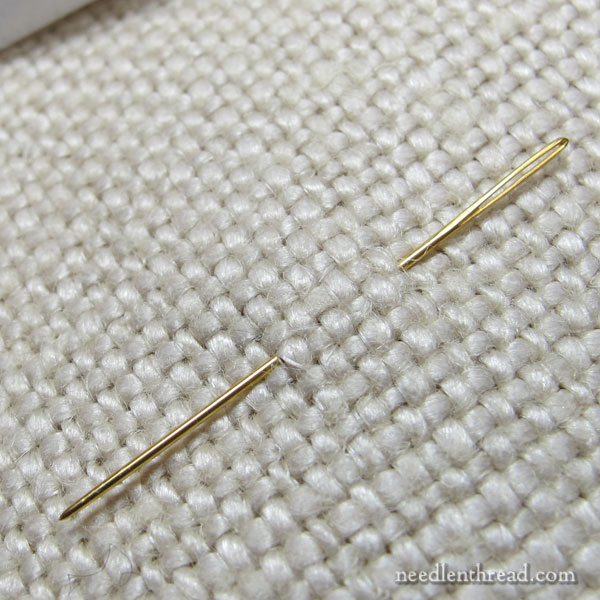
Now, to show you how this linen differs from most other linens on the market sold for needlework, here’s a close-up photo of it. The needle shown is a size 26 tapestry needle.
Notice the weave of the linen. Notice how the threads in the weave fill up the whole weave. They are nice and plump, and they don’t leave open areas in the weave, where skinny threads don’t quite fill things up.
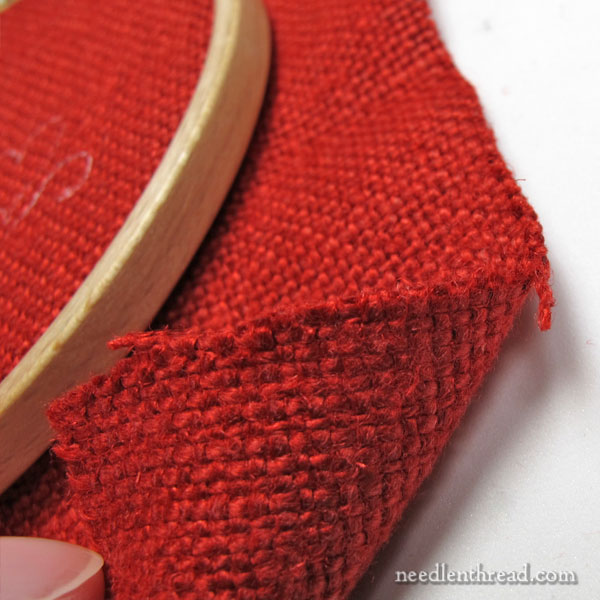
In the photo above, I tried to give you a sense of the weight of the fabric, by cutting it and folding it back on itself a little bit. It is a heavy weight linen. It’s quite a bit thicker than other linens you might be used to, but it’s also that much sturdier!
The linen, straight out of the package when you buy it, has a nice “hand” (or surface feel) to it, and it is not very stiff. If you’re used to selecting linen or other needlework fabrics that are very stiff when you first purchase them, this is not that type of fabric.
It seems to me that, generally, the lower the quality of fabric, the greater amount of sizing is used on it before it’s bolted up and packaged for marketing. Higher quality fabrics don’t require a lot of sizing in them to keep them in shape before the consumer purchases them. So, when you are out and about, looking for needlework fabric, if you find fabric that’s super-stiff, that’s because it needs a lot of sizing to keep it presentable for the consumer.
This particular linen has body to it (as good linens do), but it isn’t stiffened up with a lot of sizing. I’m sure there’s some sizing in it, to make bolting easier, but there isn’t enough in it to make it super stiff.
You can do a lot with this linen – from dense surface stitching with heavier threads, to cross stitch, Hardanger, and even rustic drawn thread work. It’s a great linen for any folk-ish embroidery, but it’s suitable for regular weight stitching as well.
You could also make this linen up into items that will endure some wear and tear, like tote bags.
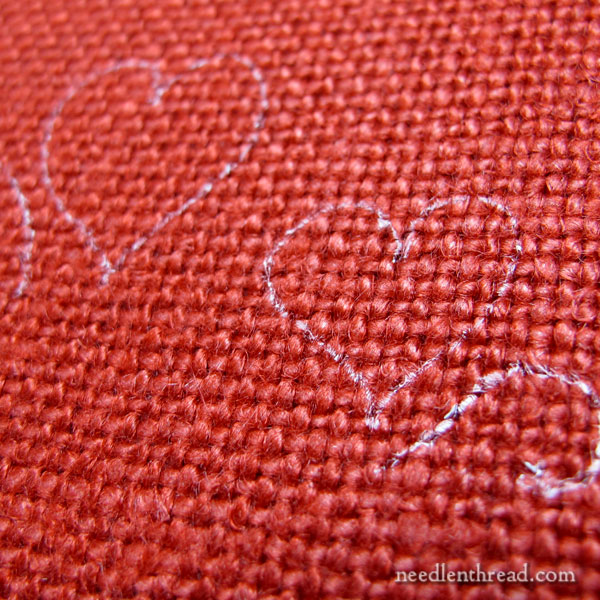
So, like I said, I wanted to get a little design worked up for you, to show you some stitching on this linen. I haven’t had a chance to do that yet.
But I spent a little time doodling about with the linen, just to see how it feels when stitching on it. I scribbled up some little elements on the red linen, using a white gel pen.
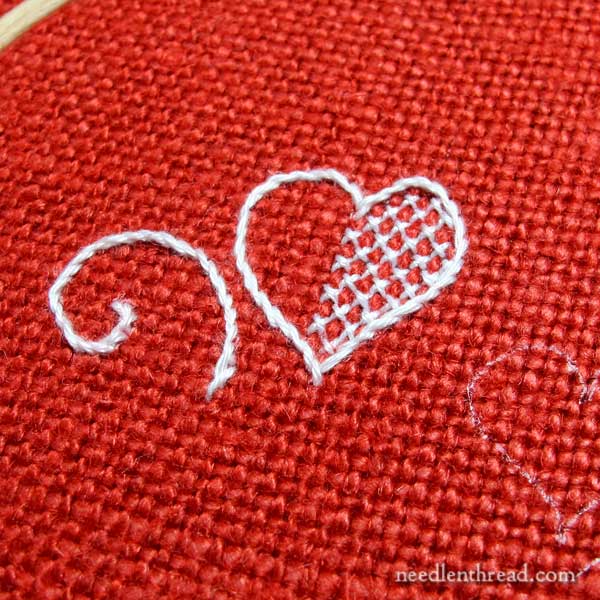
Then I took some regular whitework threads and worked stem stitch around the lines. For the fun of it, I filled half the heart with a checkered cross stitch pattern.
The moral of the story is this: the linen takes surface line stitches really well – you can achieve smooth curves without being constrained by the gridded effect of the weave. And it takes counted stitches well, too! So the two can be effectively combined on this linen, which opens up some interesting design possibilities!
When working satin stitch or long and short stitch with finer threads, it might help to back the linen with a cotton muslin, just to make sure there’s a good support structure to ensure smooth edges on the filled areas. With heavier threads, I don’t think it would be necessary, but I haven’t tried these two approaches yet. I will soon!
In fact, I can’t wait to work the little project that I have in mind for this fabric! It’s a little folky design, stitched in heavier threads, combining counted and surface embroidery. I’ve had the plan for the design for a while, but no idea what fabric to work it on. When I read about Provincial 20-count and saw the denseness of the weave, I new it would be a perfect match!
Where to Find 20-count Provincial Embroidery Linen
Check locally owned needlework shops and any needlework shop that carries goods from Access Commodities.
Online shops that I know carry linens from Access Commodities (so they could special order this if you want it) include Needle in a Haystack in Alameda, CA; Threadneedle Street in Issaquah, WA; and A Stitching Shop in Denver, CO.
In Canada, check with Traditional Stitches in Calgary, AB.
In Australia, All Threads Embroidery carries some Legacy Linen.







Dear Mary
Like you Mary I love linen and the Provincial linen looks very thick and sturdy for a 20 count linen, sometimes I find 20 count very flimsy but then it depends on the brand of the linen. I like the fact that it comes in different colours. It’s such a shame that in the UK you can’t buy good quality linen like Provincial. I can’t wait for you to share with us your stitching using Provincial linen and your overall views. Thanks for sharing the information of the new linen and your views so far on it, I don’t know how you find out about these things, but great news.
Regards Anita Simmance
Fun! Love those colors, too.
This looks like lovely linen! Thanks for the review and advice tips.
When you have a chance, would you give it a simple test run with some tambour embroidery? I’d like to know how well it handles the usual coton a broder, and if you’d recommend a backing fabric with it.
Hi, Kathy – I probably wouldn’t use a tambour needle with this, although I don’t see why it would t work. The white thread in the little sample is done with coton a broder, size 20 for the outline and size 25 for the cross stitch.
This looks good for “over one” cross stitch, too! Cool!!
Mary I haven’t embroidered on linen yet. Aside from being an evenweave, why would I want to use 20 ct as opposed to 30 or 40 ct?
Thanks.
Hi, Cynthia – well, it just depends on what you want to do with your design, and what type of stitching you’re doing. You might want to use it for the weight of the fabric, you might want it for producing bolder counted design areas, you might want to use it for the texture that the weave provides… it just depends!
What gorgeous colours and gorgeous plump threads! That’s a linen I’ll look out for if ever I need a linen with a lower count!
Hi Mary,
Love your blog! Would this linen be a good choice for crewel with Appletons wool? best, Betsy
Hi, Betsy – I wouldn’t necessarily use this with traditional crewel embroidery, because the weave is “large” and I think it would perhaps compete too much with the crewel work. Linen twill, or a higher count linen with a full weave would work better, I think. That said, I think wool threads would work well on the fabric.
The fabric looks wonderful! You just want to reach inside the screen and grab a handful ;-)Do you know by any chance if there are stores in Europe (UK or Germany) that carry it?
And I´m really looking forward to your project, you made me very courios!
All the best wishes!
Marion
Hi, Marion – I’m not sure about suppliers in Europe, but I’ll keep an eye out!
What great looking fabric. I especially love the fluffy aspect. You’re right – too many linens I find at stores are stiff and rather puny. I can see my hand through them. 🙂
Do you know if the red is colorfast? I’ve had projects ruined by red fabrics and threads that I thought were safe but turned out they weren’t. My mistake for assuming anything.
And thank you for sharing the names of stores that carry this. That’s a huge help. When I go to Texas this fall to see my son, I’ll be sure to ask for this at Stitches from the Heart.
I’ll test it and let you know, Irene. I’m planning on using the red for the project I’ve got in mind, so before I launch into it, I’ll definitely test it. I suspect it is colorfast, but I don’t want to assume, either! 🙂
I just got mine, it’s got a lovely feel in the hand.
FYI: I don’t think it’s evenweave though. My square motif is a full quarter inch wider than it is high.
Perfect for a rustic look!